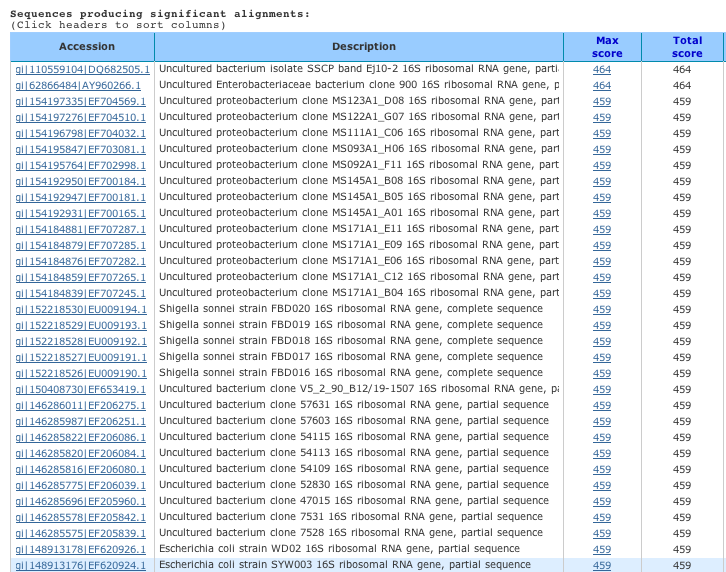ANALYZING DNA SEQUENCE SIMILARITY ON THE COMPUTER IN
7 CHAPTER 7 ANALYZING CONSUMER MARKETS AND BUYER8 ASPECTS MULTIPURPOSE TOOL FOR ANALYZING YOUR TEACHING WITH
A SUBSYSTEM ANALYZING GEORGIAN WORDFORMS AND ITS APPLICATION TO
A4 ANALYZING THE RESULTS A4 IS USED TO
AN INDEPTH LOOK AT STUDENTS’ WORK ANALYZING STUDENTS’ WORK
ANALYZING AN ARTICLE NAME 1 TITLE OF ARTICLE 2
Go to:
Analyzing DNA Sequence Similarity on the Computer
In this exercise, you will obtain the sequence of a gene from an opposum and find all known genes that are related to that gene’s DNA sequence. You will then compare the sequences of your gene to all of its relatives. You will learn how to use this information to determine the evolutionary relationships between different species.
Instructions:
Part A: Obtain the sequence of a specific gene from the opposum.
1. Open a web browser program and go the website NCBI:
http://www.ncbi.nlm.nih.gov/entrez/
This brings you to a database called the NCBI Entrez database, which contains the sequence of every gene that has ever been sequenced.
2. In the search window at the top of the page, first select the word “Nucleotide” from the pull-down bar. Then, in the text box next to the pull-down bar, type in “Monodelphis domestica low density lipoprotein receptor.” Click on the first result that appears:
“AY871266.1”. (Alternatively, you can just search for this file name in order to obtain the desired database entry.) This file contains the sequence of a gene from opposum called the LDL receptor. LDL stands for Low Density Lipoprotein, which is commonly known as “bad cholesterol.” LDL receptors are used to bring “bad cholesterol” into cells.
3. Scroll down to the bottom of the page to the section entitled ORIGIN. Highlight the DNA sequence shown there, and then press “apple-C” to copy this sequence. Later, you will paste this sequence into another search box by clicking “apple-V.”
Part B: Search a genome database for all known closely related genes to your gene of interest.
Now we will search a genome database for all known genes that have sequences that are similar to this LDL receptor protein from the opposum.
1. Open a web browser program and go the website BLAST:
http://www.ncbi.nlm.nih.gov/blast
Under the heading “Basic BLAST,” click on “nucleotide blast.”
2. Paste the gene sequence (by clicking “apple-V) you obtained in Part A into the large search box on the BLAST website labeled: “Enter accession number, gi, or FASTA sequence.” In the “Choose Search Set” section, select from the pull-down menu the option “Nucleotide Collection (nr/nt).” In the “Program Selection” section, pick the option “Somewhat similar sequences (blastn).” Click the blue button that says “BLAST.” The database of all known sequences is now being searched for those that resemble your sequence. The page will automatically update until the search is done. This may take a minute or two.
3. Scroll down past the box of red lines, and you will see information in a chart that looks like this. This chart is just an example – it is not the one you will actually see.

As you can see in the example above, the first two full names (genus and species) of organisms that come up are Shigella sonnei and Escherichia coli. Let’s zoom in on the last two lines:



![]()



This part shows the name of the species in which the sequence is found.
This part shows the name/function of the gene that contains your sequence.
This part shows the score for how well the sequence you obtained in the search matched the sequence you entered into the database. The higher the score, the better a match it is. Scores in the range of 500 indicate very good matches. This score takes into account how identical the two sequences are (the “Query coverage” column) and over how long of a stretch of DNA the two sequences are that similar.
4. Record the information from your search in the table on the next page.
Record the seven different species that contain the closest known matches to your sequence. For each species, write its Latin name, its common name (i.e. what you would call it in a non-scientific conversation), and the score that indicates how good of a match your sequence was to that entry in the database.
** Do NOT list the same species more than once in your chart. List 7 different species.
|
|
Species name in Latin (Genus species) |
Common Name (obtained from Google Image searches) |
Total Score |
|
1 |
|
|
|
|
2 |
|
|
|
|
3 |
|
|
|
|
4 |
|
|
|
|
5 |
|
|
|
|
6 |
|
|
|
|
7 |
|
|
|
Now answer the following questions, which relate to the phylogenetic trees that we made earlier.
1. Compare the total scores showing the similarity between the opposum, platypus, cow, and macaque genes for the LDL receptor. Are these results consistent with the tree you made earlier using DNA sequence? Why or why not?
2. If you had to add in the species Homo sapiens to the tree we made, where would you place it and why?
3. If the LDL receptor gene from elephant had been sequenced and was thus in the database, what total score would you predict that you would have acquired from this search? Explain your answer.
ANALYZING AND SYNTHESIZING THE RULE CONTRACTS STEP ONE
ANALYZING DNA SEQUENCE SIMILARITY ON THE COMPUTER IN
Analyzing Interactions Among Different Genes as i Discussed in
Tags: analyzing dna, analyzing, computer, similarity, sequence
- S PECIFIC ROLE PROFILE POLICE STAFF ROLE SPECIFIC INFORMATION
- VIDSTE DU AT EG BOLIG DATA LET KAN
- RISK FACTORS FOR DUAL SENSORY IMPAIRMENTS PREPOST NATAL CONDITIONS
- X X BIENAL DE LA REAL SOCIEDAD ESPAÑOLA DE
- SKILLS IDENTIFICATION A SKILLS ARE THE PERFORMANCE SPECIFICATIONS OF
- STUDIU DE PIATA DENUMIRE PRODUSESERVICII MODALITATEA DE SOLICITAREOBȚINERE
- BRAVEWEB TIME ENTRY X OPENING YOUR TIMESHEET 1 TYPE
- SCHOLARSHIP NAME PROVIDER TYPE OF SCHOLARSHIP CRITERIA WEBLINK COMMONWEALTH
- REGULATORY DOCUMENTATION CHECKLIST PURPOSE TO ENSURE THAT ALL ESSENTIAL
- MEMORIA EJERCICIO SOCIAL Nº 94 (01012014 AL 31122014) PROLOGO
- HACIA UNA EDUCACIÓN DESDE UNA PERSPECTIVA DEL SUJETO AUTORA
- WWWNAVARRAES REAL DECRETO 6461991 DE 22 DE ABRIL SOBRE
- 2 LICDA ANA I BARRANTES MUÑOZ 17 DE FEBRERO
- TEMELJEM ČLANKA 6 PRAVILNIKA O KREDITIRANJU STUDENATA S PODRUČJU
- Ðïࡱáþÿ ¥áx80ð¿ôbjbjwùwù85³5³xÿÿÿÿÿÿ·××××××z¢üû!cccccûhhû¥¥¥chhõ¥cõ¥¥¥hÿÿÿÿàdcx9f)ï8y¥á20b¥yl¥¥cc¥cccccûû¥ Êmodlitwa do Ducha Zwitego wg Kardynaba Merciera
- EFFTER FRANTZOSEN TILFOGAT DHET BRANDENBURGISKE CORPO SOM STÅDT WIDH
- QUY CHẾ CHÀO GIÁ CẠNH TRANH CẢ LÔ CỔ
- EL PRETÉRITO – LOS VERBOS REGULARES HABLAR COMER VIVIR
- STUDENCI STUDIÓW DZIENNYCH KORZYSTAJĄCY Z POMOCY MATERIALNEJ STAN
- WAR ON TERROR THE ESCALATION TO EXTREMES ABSTRACT WHAT
- PĀRTIKAS UZŅĒMUMU FEDERĀCIJAS DALĪBNIEKA PIETEIKUMS (UZŅĒMUMA VAI
- PIELIKUMS NR1 VALSTS MEŽA DIENESTA IZSOLES „PAR TELPU RŪJIENAS
- SPECIAL CITY COUNCIL MEETING MINUTES JULY 23 2012 630
- ABOUT MAXIMUM SPECIFIC HUMIDITY AND TEMPERATURE IN THE ATMOSPHERE
- C OCHRANE [NAME] GROUP VERSION AND DATE V1 19
- INTERNATIONAL SOCIAL SERVICE HONG KONG BRANCH MIGRANTS PROGRAMME
- NORMA DE SEGURIDAD SOLDADURA ELECTRICA COMO CUALQUIER
- WHITE IN IRELAND LTD (WORK EXPERIENCE HOUSING INTERNSHIP TRAINING
- ENAM 375 ANNOTATED BIBLIOGRAPHY “A POEM IS BEST READ
- RELACIÓN 11 1 ¿CUÁNTOS GRAMOS Y CUÁNTOS LITROS DE
BÁCSKISKUN MEGYEI 03 ORSZÁGGYŰLÉSI EGYÉNI VÁLASZTÓKERÜLETI VÁLASZTÁSI IRODA 6300
MINUTA SUGESTÃO CONTRATO INDIVIDUAL DE TRABALHO POR PRAZO DETERMINADO
 PREFEITURA MUNICIPAL DE PRIMAVERA DO LESTE SECRETARIA
PREFEITURA MUNICIPAL DE PRIMAVERA DO LESTE SECRETARIA 11 DEL PLAN A LA ACCIÓN 27
11 DEL PLAN A LA ACCIÓN 27VECTORS CAUTION LEARN HOW TO ADD VECTORS IT
FINAL REPORT TASK FORCE REVIEW OF ISSUE 1 FUNCTIONAL
PREDELLI AND CARPINTERO ON LITERAL MEANING FRANÇOIS RECANATI INSTITUT
Pecs el Sistema de Comunicación por Intercambio de Figuras
HISTÒRIA SEGON DE BATXILLERAT EDITORIAL VICENS VIVES TEMARI TEMA
 NEW PATIENT REGISTRATIONHEALTH QUESTIONAIRECHILD TO THE PARENTGUARDIAN TO REGISTER
NEW PATIENT REGISTRATIONHEALTH QUESTIONAIRECHILD TO THE PARENTGUARDIAN TO REGISTEREN SU DÍA INTERNACIONAL LAS PERSONAS MAYORES JUBILADOS Y
 A NEXO 8 MÓDULO DE FORMACIÓN EN CENTROS DE
A NEXO 8 MÓDULO DE FORMACIÓN EN CENTROS DECAPITOLATO SPECIALE PER L’EROGAZIONE DEL SERVIZIO DI ASSISTENZA DOMICILIARE
 RIDAS REVISTA IBEROAMERICANA DE APRENDIZAJE SERVICIO ES UNA REVISTA
RIDAS REVISTA IBEROAMERICANA DE APRENDIZAJE SERVICIO ES UNA REVISTA 0 ABILITY TOOLS QUARTERLY REPORT REPORTING PERIOD JANUARY 1
0 ABILITY TOOLS QUARTERLY REPORT REPORTING PERIOD JANUARY 1 12092018 MEDIO AMBIENTE SUELTA DOS EJEMPLARES DE VISÓN EUROPEO
12092018 MEDIO AMBIENTE SUELTA DOS EJEMPLARES DE VISÓN EUROPEO AFFIX PASSPORT SIZE PHOTOGRAPH JEEVASARTHAKATHE HEALTH AND FAMILY WELFARE
AFFIX PASSPORT SIZE PHOTOGRAPH JEEVASARTHAKATHE HEALTH AND FAMILY WELFARE LA EVOLUCIÓN DEL PERSONAJE SANCHO PANZA EN MIGUEL DE
LA EVOLUCIÓN DEL PERSONAJE SANCHO PANZA EN MIGUEL DETWITTER HTTPTWITTERCOMCURSOESPERANTO 1 SALUTON! LA KURSO DE ESPERANTO EKAS
 KLJUČNI ELEMENTI USPEŠNE PRODAJE (DVA DANA) 17 18 MART
KLJUČNI ELEMENTI USPEŠNE PRODAJE (DVA DANA) 17 18 MART